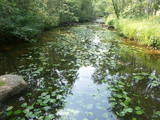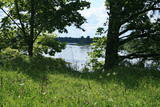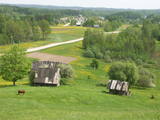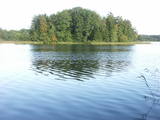| Nr | Name | Beschreibung |
|---|---|---|
|
Die Landwirtin baut verschiedenes Gemüse im ökologischen Anbau an. Zudem gibt es Obstbäume und Beerensträucher. Es gibt zwei Kühe alter und daher geschützter Haustierrassen und Pferde der Rasse Stämmige Zemaitukai. Sie ist Vorsitzende des Klubs für Arbeitspferde. Auf dem Hof werden auch verschiedene Feste veranstaltet, wie das Kräuterfest (Mariae Himmelfahrt), Herdenaustrieb. |
||
|
Pitas ir pēc inovatīvas žāvēšanas tehnoloģijas radītas augļu, ogu un garšaugu garšvielas, kuras ražo mājražotāja Lorita Miķelsone. Mājražotāja labprāt ļaus nodegustēt un iepazīstinās ar Pitām jebkuru interesentu, uzņemot apmeklētājus Skaisto un praktisko ideju dārzā Dobelē. |
||
|
Dieses Gebiet schützt den Kalksteinaufschluss, der an den Ufern des Unterlaufs der Zaņa gefunden wurde. Hier gibt es einen Pfad für aktive Wanderer, der an der Zaņa – Mühle beginnt (1864, wiederaufgebaut 1890, niedergegerissen 1960). Der Pfad windet seinen Weg entlang der Ufer des kleinen Flusses in Richtung zu seiner Mündung.
|
||
|
Meklējama pilsētas centrā - Tirgus laukumā 11. Dievnams uzcelts 1886. g. Ēkā atrodas vairāki nozīmīgi mākslas pieminekļi – gleznas, krucifikss (18. gs.) u.c. Baznīcas dārzā apskatāma skulptūra “Latgales māte” (tēlnieks B. Buls) un piemineklis politiski represēto piemiņai (tēlniece V. Dzintare). Baznīca ir apskatāma arī no iekšpuses. |
||
|
Das Café befindet sich auf dem Marktplatz von Vecpiebalga, gegenüber der evangelisch-lutherischen Kirche. Es arbeitet mit lokalen Bauern zusammen und verkauft die Produkte der Räucherei Piebalgas kūpinātava. Lettische Küche: Knusprige Schweinhautstücke, Kartoffelpfannkuchen, kalte Rote-Beete-Suppe, gebratenes Schweinefleisch, Lammwürste mit geschmortem Kraut, hausgemachte Bratwürste, Zanderfilet, dünne Pfannkuchen, in Piebalga gesammelter Honig, Sumpfbrombeeren-Marmelade, Erdbeersuppe mit Eis. Das besondere Gericht: Soljanka von "Ķeņcis". |
||
|
Die Dünen nördlich Pervalka über dem ehemaligen Dorf Negeln. Eine 9 km lange Strecke mit den wüstenartigen Landschaften. Stegpfade. |
||
|
Ventspils ist eine der reichsten Städte in Lettland. Die Stadt erfreut mit einer ausgezeichneten Infrastruktur, einer sehr gut restaurierten Altstadt, einer Burg des Livländischen Ordens, mit sauberen, gut eingerichteten und weiß-sandigen Stränden, mit einer Promenade, schönen Fontänen, Blumenskulpturen, gepflegten Parks und verschiedenen Attraktionen. Die ganze Stadt ist familienfreundlich, aber die Kinder genießen am meisten den Strand der Blauen Flagge mit unterschiedlichen Schaukeln, Kletter- und Rutschmöglichkeiten, sowie die Kinderstadt, die in Zonen für Aktivitäten für unterschiedliche Altersgruppen eingerichtet ist. Die kurze Fahrt mit der Schmalspurbahn Mazbanitis zieht nicht nur Kinder, sondern auch Erwachsene an. Spazierpfade und Radrouten, sowie die Fahrt mit einem Schiff für Touristen bieten gute Möglichkeiten, die Stadt und die Küste zu erkunden. In Ventspils kann man Wasserfreuden sowohl in einem Indoor-Wasserpark, als auch in einem Outdoor-Wasserpark genießen. Wir empfehlen, zwei Ausflüge zu der malerischen Küste zu machen: Einen Ausflug in die traditionellen Fischerdörfer, wo man von den örtlichen Fischern frisch geräucherte Fische kaufen kann, und in den Nationalpark Slitere, wo man aus einem Leuchtturm eine wunderbare Aussicht genießen kann, und den zweiten Ausflug in die reizvolle Stadt Kuldiga, die mit ihrer hölzernen Architektur bekannt ist. Es ist leicht, diese Ausflüge zu unternehmen, weil die Straßen in diese Richtungen meistens ziemlich leer sind. |
||
|
Die Besichtigung der Stadt Sigulda kann man mit dem Besuch der Burgruinen anfangen. Mit dem Bau der Burg hat der Schwertbrüderorden im Jahr 1207 begonnen, aber im Jahr 1236 wurde die Burg für die Bedürfnisse des Livländischen Ordens umgebaut. Die Burg hat sehr stark in den Kriegen in der zweiten Hälfte des 16. Jhs. und am Anfang des 17. Jhs. gelitten. Während des Nordischen Krieges wurde die Burg niedergebrannt und danach nicht mehr erneuert. Heute kann man das südwestliche Gebäude des Konvents und den Turm des Haupttors besichtigen, hinter dem sich die innere Vorburg mit einer Freilichtbühne befindet, aus der sich eine eindrucksvolle Aussicht auf das Urstromtal von Gauja eröffnet. Zurzeit werden in den Burgruinen Rekonstruktionsarbeiten durchgeführt. Das Neue Schloss von Sigulda, das sich im Süden befindet, wurde von 1878 bis 1881 (der Inhaber – Fürst Kropotkin) gebaut. Von 1923 – 1940 befand sich in diesem Gebäude das sogenannte Schloss der Schriftsteller, aber während der Sowjetzeit – ein kardiologisches Sanatorium. Seit 2003 befindet sich hier die Kreisverwaltung von Sigulda. In dem Landgutkomplex haben sich ein Wohnhaus aus Holz (Mitte des 19. Jhs.), wo die Familie von Kropotkin wohnte, eine Kornkammer (Jahrhundertwende 18.-19. Jh.), ein Gartenhaus (19. Jh.) und ein gemauerter Zaun (19. Jh.) erhalten. Falls wir von dem Neuen Schloss nach Nordosten gehen, werden wir in fast 2 km an dem Tal des Flusses Vējupīte kommen, wo man die flache (3,6 m), aber hohe (6,1 m) Höhle Pētera ala (die Höhle von Peter) und das Tal Pūču grava (Eulental) mit dem kleinen Fluss Kraukļupīte besichtigen kann. An der Stelle, wo sich die beiden Täler zusammentreffen, erhebt sich der Burgberg von Satezele (Hügelfläche 90 x 75 m), wo sich im 13. Jh. die Burg aus Eichenholz von Dabrelis befand, der der Leiter (der Älteste) der Liven war. Unweit kann man das Tal Kraukļu aiza (Rabenschlucht) – das Seitental des linken Ufers von Vējupīte mit 11 m hohen Sandsteinwänden – und die 5,2 m tiefe Höhle Kraukļu ala (Rabenhöhle) finden. An der Stelle, wo sich das Tal von Vējupīte und das Urstromtal von Gauja zusammentreffen, erhebt sich der Hügel Paradīzes (Gleznotāju) kalns (Paradiesberg oder Malerberg), der landschaftlich ein sehr schöner Ort und schon seit alten Zeiten gemalt und fotografiert worden ist! Zum Hügel Paradīzes kalns kann man mit einem Elektromobil gelangen. Im Westen von Sigulda kann man das Panoramarad (geöffnet während der Sommersaison) und die Luftseilbahn benutzen, die 1969 gebaut wurde und in den baltischen Ländern als einziges Transportmittel seiner Art ist. Das Tragseil der Bahn ist 1060 m lang und ohne Stützen verbindet es in der Höhe von ungefähr 40 m über den Fluss Gauja die Ufer des Urstromtales Gauja zwischen Sigulda und Krimulda. Hier eröffnen sich wunderbare Aussichten! Im Südwesten von Sigulda kann man bis zur Steilwand Beites krauja spazieren, die von einem Tal eines Baches durchgespaltet wird. Im Westen des Tals befindet sich der Ort Ķeizarskats (Kaiseraussicht), der sich ungefähr 67 m über den Fluss Gauja erhebt und aus dem man eine gute Aussicht nach Krimulda und zur Burg von Turaida hat. Dieser Aussichtspunkt wurde hier schon 1862 eingerichtet, als Sigulda der russische Kaiser Alexander III besucht hat. Im Osten des Tals befindet sich der aus Holz gebildete Ķeizarkrēsls (Kaiserstuhl). |
||
|
Die gemütliche Gaststätte in der Innenstadt von Elva sorgt nicht nur für einen vollen Magen, sondern auch für eine freundliche Atmosphäre. In der vielfältigen Speisekarte können sogar wählerische Gäste ihre Lieblingsgerichte finden, darunter auch Veganer. Man kann Räume mieten und Essen bestellen. In der Sommersaison steht auch eine Außenterrasse zur Verfügung. |
||
|
Südlich von der Stadt Ventspils, in der Nähe vom Küstenpark. Die Bauarbeiten der Batterie begannen im Jahr 1939. Das ungepflegte, verschmutzte und vernachlässigte Militärobjekt ist ein schroffer Gegensatz zu die gepflegte Stadt. Auch die „Gewinner” der Baumaterialien und der Metalle haben viel Mühe gegeben.... Schade, dass so ein historisches, potentielles Tourismusobjekt in solchem Zustand von den Toren der Stadt liegt.
|
||
|
In der Getreidedarre des Hofes Atāli auf der Insel Putnu sala (Vogelinsel) hat die örtliche Heimatkundlerin Ārija Gruberte 20 Jahre lang Haushaltsgegenstände gesammelt, die in der Umgebung des Urstromtales von Dviete verwendet worden sind. In der Ausstellung kann man verschiedene Gegenstände aus der Steinzeit, Eisenzeit und aus dem Mittelalter besichtigen, die zufällig gefunden worden sind und die über das Leben der Menschen innerhalb von 10 000 Jahren zeugen. Den Besuch bitte vorher anmelden. |
||
|
Der dritgrößte Feldstein im Baltikum (584 m3, 7 m hoch, Durchmesser bei dem Grund – 32 m ). Auf estnisch bedeutet „Hausstein”. Befindet sich am Rande des Pikanõmme – Majakivi Pfades (4,5 km lang). |
||
|
Маршрут проходит по территории природного парка «Излучины Даугавы». Парк создан с целью сохранения уникальных ландшафтов древней долины Даугавы, биологического многообразия и богатейшего культурно-исторического наследия. Наибольшую высоту берега реки достигают в т.н. «Воротах Даугавы», где возвышаются Верверский и Слутишкский обрывы. С Приедайнской смотровой вышки открывается вид на древнюю долины Даугавы с высоты птичьего полета. В 2015 году в Васаргелишках и на горе Лаздукалнс были построены новые смотровые вышки. Информация о маршруте от Latvijas Lauku forums |
||
|
Das Museum für Pferdewagen befindet sich im Beigut Pilkuse. Zu den Exponaten gehören Pferdewagen und -schlitten sowie Zubehör (Krummhölzer, Kummet, Schellen, ebenso Schlittendecken und Moorschuhe für Pferde). Hier sind Kriegs-, Nothilfe- und Feuerwehrwagen. Perlen des Museums sind eine Kutsche und eine Kalesche, darüber hinaus gibt es viele Feldgeräte. Es gibt viele sehenswerte und interessante Exponate |
||
|
Ein bedeutender Ort der lettischen Geschichte, denn hier befand sich im 12. und 13. Jh. das amtliche und auch kulturelle Zentrum des alten lettgalischen Landes Jersika mit der Burg des Herrschers Visvaldis am 18m hohen Ufer der Daugava, wo sich der mächtige Burghügel erhebt. |
||
|
Das ist eine der am meisten von der subglazialen Depression ausgeprägtesten Landschaften in Lettland mit 11 Seen verschiedener Größe und Tiefe. Das ist eine faszinierend schöne Landschaft mit besonders eindrucksvollen Aussichten von Drusku – Burgberg. An einem klaren Tag kann man das Hanja – Hochland von Estland sehen. Das geschütze Territorium wurde eingerichtet, um das Gebiet des Nördlichen Nadelwaldgürtel zu schützen.
|
||
|
Dieses Terrotorium schützt den See Jumurda, der sich im zentralen Teil des Vidzemer Hochlandes befindet, mit seinen drei Inseln, dem lokalen Laubwald und den umgebenden Landschaften.
|
||
|
Muiža vēsturiskajos dokumentos pirmoreiz ir pieminēta 16. gs. Tagad redzamā vienstāva kungu māja ir vairākreiz pārbūvēta laikā no 17. – 19. gs. 1997. g. ēku vēlreiz atjaunoja un tagad tajā atrodas viesu nams un Vilsandi nacionālā parka apmeklētāju centrs, kur var iegūt ne tikai vērtīgu informāciju, bet arī apskatīt Vilsandi apkārtnē atrastās fosilijas. No Lonas muižas var uzsākt pārgājienu uz Vilsandi salu. Vienā no muižas ēkām ir izveidota Vilsandi nacionālajam parkam veltīta ekspozīcija. |
||
|
Der Name Ķemeri (Kemmer) ist in den schriftlichen Quellen zum ersten Mal im Jahr 1561 erwähnt worden. In der zweiten Hälfte des 18. Jhs. und am Anfang des 19. Jhs. war der Heilcharakter der Schwefelquellen und der Schlammbäder von Ķemeri sehr gut bekannt, darum ließen sich hier die höheren Kreise von Kurland behandeln. Die Gäste wurden von den einheimischen Forstaufsehern aufgenommen. Zu dieser Zeit wurden hier die ersten Schlammbäder genommen. Die Entwicklung der Badeorte Jūrmala und Ķemeri wurde für eine Weile von dem Vaterländischen Krieg im Jahr 1812 unterbrochen. Zwei Jahrzehnte später – von 1833 bis 1835 hat die Qualitäten von Ķemeri der baltische Generalgouverneur Graf Carl Magnus von der Pahlen ausprobiert, der die Aufmerksamkeit des russischen Zaren Nikolai I auf die Unterstützung der Entwicklung des Kurortes wendete. Die Bitte wurde unterstützt und im Jahr 1836 stellte der Zar 700 Hektar Staatsland und 100 000 Rubel für den Bau einer Heilanstalt und für das Pflastern der Straße von Ķemeri bis zu der großen Straße Sloka – Tukums bereit. Zwei Jahre später (1938) wurde die erste staatliche Badeanstalt eröffnet. Dieses Jahr wird auch als das Gründungsjahr des Kurortes angenommen. Der Ruf des Kurortes verbreitete sich im ganzen Russischen Reich und er wurde immer mehr bekannter. In mehreren Etappen wurde mit der Einrichtung des Parks von Ķemeri begonnen, der ein bedeutender Teil des Kurortes ist. In der Mitte und in der zweiten Hälfte des 19. Jhs. förderte die weitere Entwicklung des Kurortes sowohl der Dampferverkehr, als auch die im Jahr 1877 eröffnete Eisenbahnlinie von Riga nach Tukums. Im Jahr 1912 wurde die direkte Bahnverbindung Ķemeri – Moskau eröffnet. Kurz vor dem Ersten Weltkrieg erreichte die Zahl der Patienten 8300 Menschen pro Jahr. Das Moor von Ķemeri war für mehrere Jahre die Frontlinie des Ersten Weltkriegs und der Kurort wurde erheblich zerstört. Trotzdem blühte der Kurort nach dem Krieg schnell auf und Ķemeri wurde zu einem beliebten Erholungsort der Einwohner von Riga und zu einer der modernsten Kuranstalten in Europa. Im Jahr 1924 wurde in Ķemeri eine neue Badeanstalt mit Schlammbädern gebaut, die zu dieser Zeit eine der modernsten Badeanstalten in Europa war. Im Jahr 1936 hat der Staatspräsident Kārlis Ulmanis einen der bedeutendsten Bauten der ersten Unabhängigkeit Lettlands – das Hotel Ķemeri – eröffnet. Auch nach dem Zweiten Weltkrieg – während der Sowjetzeit – hat sich der Kurort erweitert und in seiner Umgebung wurden fast 10 Sanatorien eingerichtet, wo ungefähr 100 Ärzte gearbeitet haben. Im Jahr 1971 hat Ķemeri den Status als der Kurort der Sowjetunion erlangt. In der Zeit zwischen 1975 – 1985 wurde in Ķemeri das größte Sanatorium mit dem Namen Līva (in seinen Anfängen Latvija) gebaut, das zwei Gebäude, jedes mit elf Etagen hatte. In dem Sanatorium konnten gleichzeitig bis zu 1200, aber in einem Jahr – bis zu 140 000 Patienten behandelt werden. Das Sanatorium wurde am Anfang der 1990er Jahre als unrentabel geschlossen. Bis 1994 arbeiteten in Ķemeri diese fünf Sanatorien Čaika, Daugava, Dzimtene, Ķemeri und Līva (Latvija) und die Poliklinik des Kurortes Ķemeri. Die folgende Zeit kann man als den Niedergang des Rufes des Kurortes betrachten, der davor weit und breit bekannt war. |
||
|
Der Bauernhof befindet sich im malerischen Nationalpark Karula (Karula Rahvuspark). Hier kann man sowohl Essen bekommen als auch übernachten. Das Essen wird hauptsächlich mit den örtlichen Produkten in der Küche des Bauernhofs zubereitet. Im Bauernhof werden auch Fleischbullen gezüchtet. |
||



























